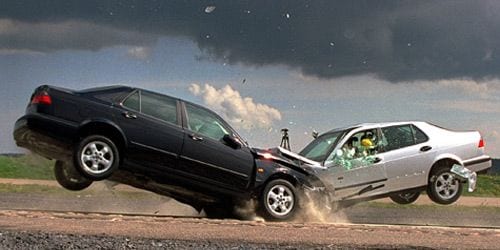
Karen Beckman of the University of Pennsylvania has produced a fascinating study of the place of the car crash in cinema. Carefully articulated with reference to Walter Benjamin, Paul Virilio, and other theorists, Beckman’s mission is “to explore how film, through the recurrent trope of the car crash, stages, excites, and disciplines the unconscious drives that pull us toward speed, risk, and the vulnerability of the self that is forged by these drives.” The wide range of her cases includes slapstick comedies, researchers’ crash tests, J.G. Ballard’s novel Crash, Andy Warhol’s Since, Alejandro González Iñárritu’s Amores perros, and Jean-Luc Godard’s Weekend, among several others.
Although the book is written as a contribution to ongoing academic debates within film studies, the author’s observations and arguments should nonetheless be interesting to film lovers. Obviously, having seen the films she so incisively discusses will contribute to the reader’s enjoyment of the book.
When I first learned of Beckman’s book and its focus, I expected Paul Haggis’s Crash to be featured prominently in the analysis. The 2005 Oscar winning film is dismissed, however, as “a clichéd and sensational depiction of racial tensions in Los Angeles, which seem to be resolved by a miraculous snowfall.” Given the richness of the films she does analyze, however, excluding the Haggis film is not problematic. Beckman’s thorough discussions of these works provide an intriguing examination of the relationship between film as moving image and the automobile as a technological advance that permitted new ranges of individual movement. She incorporates insights from other research to illustrate the affinities between the medium of film and the experience of automobile travel, the products of “two industries of modern mobile vision.” Indeed, watching the world flash by while riding in a car or bus, whether on city streets or across a verdant landscape, affords its own kind of cinematic experience.
After reviewing the place of the car crash in slapstick comedies, driver safety movies, and crash test studies (some using chimpanzees and cadavers), Beckman turns to the cinema of the ’50s and ’60s. In these films, she writes, the car “gradually became aligned with fantasies of uninhibited motion toward as-yet unrealized dreams of the future, of liberation from domesticity and the constraints of postwar society.” Although not a crash per se, an automobile—indeed, a whole motorcade—served as a scenario for a profound national trauma in 1963: the murder of President Kennedy as captured in the Zapruder film.
Having already portrayed grisly car crashes in his “Death and Disaster” series, Warhol turned his attention to the assassination, with the aid of Factory Superstars like Ondine, Ivy Nicholson, Ingrid Superstar, International Velvet, and Mary Woronov as JFK (thereby making her, according to Beckman, “perhaps the first female president on film”). Beckman convincingly shows how Warhol’s Since enables a reimagining of the link between the spectator and the televised traumatic event through the re-enactment of the assassination in the sexualized space of the Factory’s couch, a stage where the Superstar actors never fully commit to their roles.
González Iñárritu’s Amores perros brings together the lives of three groups of people through the trauma of a car crash in Mexico City. Beckman praises the film for its ambiguous position with regard to US culture and the nationalism that grips so much of the Mexican imagination. Noting the influence of the photographer Nan Goldin, Beckman argues that the film’s continuous return to the moment of the crash frames contemporary Mexico as “an endlessly traumatic present in which forward narrative movement can only be achieved paradoxically by moving backward to an already lived instant.”
Like certain other films she discusses, the impact of González Iñárritu’s approach raises questions about the experience of viewing a film. How will the spectator’s visual reception of cinematic crashes be altered as more and more films are shot in 3D? Clearly, “the impact of transportation technologies on the individual, the couple, and the family” remains a subject of great concern. Today, commercials warning against drunk driving have been joined by admonitions against texting while driving, recounting stories of young lives ended in order to exchange the most abbreviated of messages.
Reading Beckman’s work therefore demanded that I think more carefully about the place of the automobile and collisions in pop culture. Interesting cases are abundant. The opening themes of TV sitcoms celebrating the independence and careers of women, e.g., Alice and The Mary Tyler Moore Show, began with an image of a moving car on a highway, symbolizing the discarding of a past identity and individual mobility (the theme of That Girl begins with a train ride). Shows like World’s Most Amazing Videos play off the shock and horror of watching every motorist’s nightmare made real for unfortunate others. The success of the Grand Theft Auto video games is widespread, while actual police chases, often involving multiple crashes, are energetically followed and narrated via news channels’ helicopters. In film, the commercial power of the car motif endures, as seen in the popularity of the Fast and the Furious film franchise and the Disney/Pixar Cars animated film (a sequel is in production).
Also, of course, car crashes have been responsible for ending the lives of 20th century legends like James Dean, Jayne Mansfield, Jackson Pollock, Grace Kelly, and Princess Diana.

![Call for Papers: All Things Reconsidered [MUSIC] May-August 2024](https://www.popmatters.com/wp-content/uploads/2024/04/all-things-reconsidered-call-music-may-2024-720x380.jpg)



